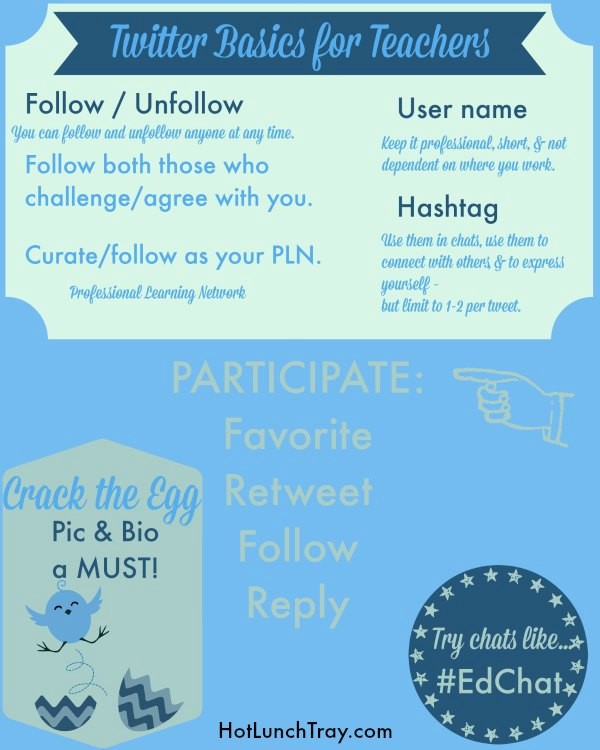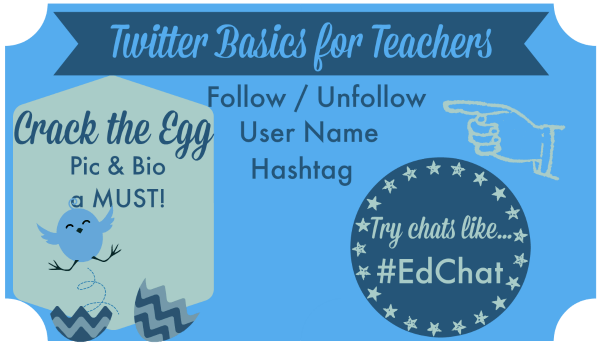What does a Teacher Need to Know about Twitter?
Twitter is by educators and offers a peer-to-peer, grassroots professional learning opportunity never before experienced by educators. Twitter is called micro-blogging because it limits messages to 140 characters at a time. Twitter can be experienced in phases of participation.
Twitter basics for teachers can be approached through vocabulary, profile essentials, and a quick start participation guide.
Vocabulary
The vocabulary of social media is new, so you’d be forgiven if you don’t know it all. And Twitter does change from time to time. The good news is that you are an educator – and you know students – so you can catch up pretty quickly!
Follow – Subscribing to a Twitter account is called “following.” To start following, click the Follow button next to the user name or on their profile page to see their Tweets as they tweet. Anyone on Twitter can follow or unfollow anyone else at any time
Unfollow – To unfollow a Twitter account, click unfollow in their profile and you have unsubscribed to their account, or tweets.
Username – A username is what you are called on Twitter, and is always preceded immediately by the @ symbol. My username is @pen63.
Hashtag – A hashtag is any word or phrase immediately preceded by the # symbol and containing no spaces. If you click on a hashtag, you see other Tweets containing the same keyword or topic.
Direct Message – Direct Messages, or DMs, are private messages sent from one Twitter user to another Twitter users. Traditionally, users have had to follow each other to DM, but that may be changing. You can use Direct Messages for one-on-one private conversations, or between groups of users.
Favorite – Favoriting a Tweet indicates that you like that Tweet. You can find all of your favorite Tweets by clicking on the favorites link on your profile page. Different people have different philosophies on what they favorite, develop your own – there is not a right way to favorite tweets.
Mention – Using another username in your tweet generates a notification to the other user’s account. This is a mention.
Retweet – RT – Retweeting another user’s tweet as-is is referred to as a retweet and gives attribution to the original account.
Modified Tweet – MT – A modified tweet had to be truncated to meet the 140 character count. Include MT and the original Twitter account.user when possible in reconstructing a MT.
Professional/Personal Learning Network – PLN – This is the group of educators/vendors/others you choose to follow on Twitter which help you to grow professionally/personally.
Profile
 Your profile is your public facing advertisement of who you are. I suggest making it public, not private. Personally I do not follow private accounts. What is the point of adding someone to a PLN if they are advertising they do not openly share?
Your profile is your public facing advertisement of who you are. I suggest making it public, not private. Personally I do not follow private accounts. What is the point of adding someone to a PLN if they are advertising they do not openly share?
People evaluate your profile when deciding to follow you. Make sure that you have “cracked the egg” already. Twitter starts everyone out with an egg from Twitter as their profile picture. If you have not given the effort to change your picture, what does that say about your ability to add to someone else’s PLN? Along that same vein, add your location (you can keep it general like a state), and something about yourself. If you have a website/blog this is a great place to add that as well!
Participation
Participation can take place in phases, phases in which you control the pace.
The first phases consists of observation. As a newbie you can follow educators you know to acquire the feel for how to tweet. You can also observe twitter chats. Here is a complete list. I would recommend saving #EdChat for a more advanced phase.
Entry level participation occurs next. You may retweet or reply to tweets as you feel more comfortable in your Twitter use.
Finally, you are able to contribute content on Twitter. You are able to sustain conversation between other Twitter users.
And then of course, you start to on-board other great educators to Twitter yourself!
See also How to #EdChat.






3 Pingbacks